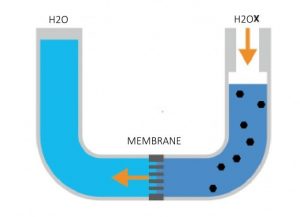Reverse Osmosis Process
Reverse osmosis is an efficient filtration method that is used to remove large amounts of contaminants from water in a way that is safe, chemical free and cost effective.
Here at Lubron, we provide bespoke, end-to-end, environmentally friendly water treatment solutions such as reverse osmosis, which help to transform the way our customers use water for the better.
What is Reverse Osmosis?
Reverse osmosis, also known as RO, is the process of purifying water by pushing it through a semi-permeable membrane to remove contaminants. The semi-permeable membrane is a synthetic lining which is designed to allow water molecules to pass through it, whilst filtering out unwanted molecules and large particles such as;
- Salt
- Sediment and dirt
- Fluoride
- Metal ions
- Chlorine, calcium, magnesium and potassium
- Arsenic, radium, phosphorous and nitrate
- Volatile organic compounds (VOCs)
- Bacteria and microorganisms
- Herbicides and pesticides
Once the majority of unwanted contaminants have been removed, you are left with safe, clear, great tasting and odor free water.
Through the application of Reverse Osmosis, bacteria (including the Legionella bacteria), as well as viruses, can be prevented.
The Reverse Osmosis Process in Water Purification
Osmosis is a naturally occurring phenomenon upon which the RO technique is based and works by reversing the process using mechanical pressure.
The process of reverse osmosis typically involves 4 stages of filtration – sediment filter, pre-carbon block, reverse osmosis membrane and post-carbon filter. Here is a brief overview of what the reverse osmosis desalination process entails;
Phase 1 – At this pre-filtration phase, the water is passed through a sediment filter to remove the largest particles such as sand, rust and dirt which helps to prevent any of the subsequent filters from becoming clogged.
Phase 2 – A pre-carbon filter is then used with activated carbon to stop contaminants from passing through to the third filter. This will include particles larger than a spec of flour as well as chemical compounds such as chlorine which can damage thin-film membranes.
Phase 3 – The water will then pass through the semi-permeable RO membrane which will remove dissolved solids including fluoride, sodium, dissolved minerals and high levels of lead.
Phase 4 – A post-carbon filter is the final stage which ‘polishes’ the water, removing any remaining aesthetic odors or taste.
Pre-Treating Osmosis Water – The thickened water which remains in the process (concentrate) is wastewater. In order to reduce the loss of water as much as possible, the feed water is pre-treated in some cases. For example, by softening the water, deposits are prevented in the membranes, therefore, pure Osmosis water with the highest possible efficiency is produced and the amount of wasted water is reduced to a minimum.


